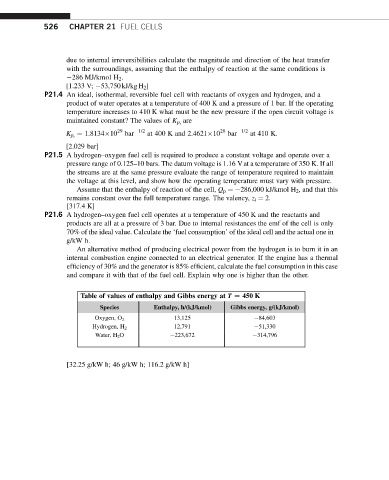Page 533 - Advanced thermodynamics for engineers
P. 533
526 CHAPTER 21 FUEL CELLS
due to internal irreversibilities calculate the magnitude and direction of the heat transfer
with the surroundings, assuming that the enthalpy of reaction at the same conditions is
286 MJ/kmol H 2 .
[1.233 V; 53,750 kJ/kg H 2 ]
P21.4 An ideal, isothermal, reversible fuel cell with reactants of oxygen and hydrogen, and a
product of water operates at a temperature of 400 K and a pressure of 1 bar. If the operating
temperature increases to 410 K what must be the new pressure if the open circuit voltage is
are
maintained constant? The values of K p r
¼ 1.8134 10 29 bar 1/2 at 400 K and 2.4621 10 28 bar 1/2 at 410 K.
K p r
[2.029 bar]
P21.5 A hydrogen–oxygen fuel cell is required to produce a constant voltage and operate over a
pressure range of 0.125–10 bars. The datum voltage is 1.16 Vat a temperature of 350 K. If all
the streams are at the same pressure evaluate the range of temperature required to maintain
the voltage at this level, and show how the operating temperature must vary with pressure.
Assume that the enthalpy of reaction of the cell, Q p ¼ 286,000 kJ/kmol H 2 , and that this
remains constant over the full temperature range. The valency, z i ¼ 2.
[317.4 K]
P21.6 A hydrogen–oxygen fuel cell operates at a temperature of 450 K and the reactants and
products are all at a pressure of 3 bar. Due to internal resistances the emf of the cell is only
70% of the ideal value. Calculate the ‘fuel consumption’ of the ideal cell and the actual one in
g/kW h.
An alternative method of producing electrical power from the hydrogen is to burn it in an
internal combustion engine connected to an electrical generator. If the engine has a thermal
efficiency of 30% and the generator is 85% efficient, calculate the fuel consumption in this case
and compare it with that of the fuel cell. Explain why one is higher than the other.
Table of values of enthalpy and Gibbs energy at T [ 450 K
Species Enthalpy, h/(kJ/kmol) Gibbs energy, g/(kJ/kmol)
13,125 84,603
Oxygen, O 2
12,791 51,330
Hydrogen, H 2
Water, H 2 O 223,672 314,796
[32.25 g/kW h; 46 g/kW h; 116.2 g/kW h]

